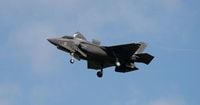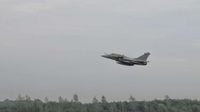For the first time since the onset of Russia’s full-scale invasion of Ukraine, air raid sirens blared across eastern Poland as authorities responded to a fresh wave of drone threats from across the border. On September 13, 2025, Polish and NATO aircraft scrambled into the skies in a high-stakes “preventive” operation, closing the Lublin airport and putting ground-based air defenses on their highest state of readiness. The move came just days after multiple Russian drones violated Polish airspace, forcing NATO to intercept them and pushing the region’s security anxieties to new heights.
According to statements from the Polish military’s operational command, the alert was raised due to a credible threat of drone strikes in Ukrainian regions adjacent to Poland. Prime Minister Donald Tusk confirmed on X, “Due to the threat posed by Russian drones operating over Ukraine near the border with Poland, preventive operations of aviation—Polish and allied—have begun in our airspace.” He added, “Ground-based air defense systems have reached the highest state of readiness.”
Residents in the border counties of Chełm, Chełmski, Krasnostawski, Łęczyński, Świdnicki, and Włodawski received urgent warnings: “Threat of an air attack. Exercise particular caution. Follow the instructions of the services. Await further announcements.” For many, it was a chilling first—the wailing of sirens across their towns since the Russian invasion began in 2022. Social media quickly filled with footage of the alarms, amplifying the sense of vulnerability and uncertainty.
The airport in Lublin, a key city in eastern Poland, was swiftly closed to civilian flights. The Polish Air Navigation Services Agency cited “military aviation activities” as the reason, and airport spokesman Piotr Jankowski told PAP news agency that the closure would remain in effect until at least 6 p.m. local time. This disruption underscored the seriousness with which Polish authorities treated the threat. As the operational command explained, “These actions are preventive in nature and aimed at securing airspace and protecting citizens, especially in areas adjacent to the threatened area.”
The heightened alert lasted about two hours before the military announced the operation was complete and systems had returned to normal. Prime Minister Tusk expressed gratitude to all involved, stating, “Thank you to all involved in the operation in the air and on the ground. We remain vigilant.”
This episode was not an isolated incident. Just three days earlier, on the night of September 10-11, Russian drones crossed into Polish airspace during a broader wave of Russian strikes on Ukraine. According to multiple reports, NATO scrambled fighter jets to intercept the drones, marking the first time alliance forces had directly engaged with Russian assets in this manner. The drones were believed to be targeting an alliance military base supplying weapons to Ukraine, further raising the stakes.
Poland described the incursion as an “act of aggression.” While Russia denied intentionally targeting Poland, and Belarus—Moscow’s ally—claimed the drones had gone astray due to jamming, European leaders were unconvinced. European Union foreign policy chief Kaja Kallas commented, “Russia's war is escalating, not ending. Last night in Poland, we saw the most serious European airspace violation by Russia since the war began, and indications suggest it was intentional, not accidental.”
The Polish military’s operational command made it clear that the country’s air defense and radar reconnaissance systems were on high alert, not just as a matter of routine, but in response to specific, credible threats. “To ensure the safety of our airspace, the Operational Commander of the Polish Armed Forces has activated all necessary procedures. Polish and allied aircraft are operating in our airspace, while ground-based air defence and radar reconnaissance systems have reached the highest state of readiness,” the command stated.
International reaction was swift. U.S. Secretary of State Marco Rubio condemned the Russian incursion as “unacceptable,” echoing a broader Western consensus that Russia’s actions were a deliberate provocation. NATO convened to discuss the incident, underscoring the seriousness with which the alliance views any violation of its members’ airspace.
The situation was mirrored elsewhere along NATO’s eastern flank. In Romania, authorities scrambled two F-16 fighter jets to intercept a drone that entered the country’s airspace near the southeastern county of Tulcea. The Romanian defense ministry reported, “The drone did not fly over inhabited areas and did not represent an imminent danger to the security of the population.” Nevertheless, citizens near the Danube were instructed to take cover, and teams were dispatched to search for any debris after the drone dropped off radar 20 kilometers southwest of the village of Chilia Veche.
These incidents have heightened long-standing concerns about the spillover effects of Russia’s war in Ukraine. Polish airspace has been violated multiple times since 2022, but never on this scale. The recent events mark a significant escalation, with NATO forces now directly confronting Russian aerial threats. As one NATO spokesperson noted, it was the first time the alliance had faced a potential threat in its own airspace in this conflict.
Despite Russia’s denials and Belarus’s explanations, many European leaders remain convinced that these incursions are intentional. The timing—coming just after Russia’s largest aerial attack on Ukraine since the war began—suggests a pattern of escalation. The message from Brussels, Warsaw, and Washington is clear: such provocations will not go unanswered, and NATO’s commitment to defending its eastern members remains steadfast.
For ordinary Poles living near the border, the events of September 13 were a sobering reminder of the war’s proximity and unpredictability. The sight of fighter jets overhead, the sound of sirens, and the sudden closure of Lublin airport brought home the reality that the conflict in Ukraine is not as distant as many might hope. As Prime Minister Tusk put it, vigilance is the order of the day.
The coming weeks will test the resilience and readiness of both Poland and its allies. With tensions running high and the risk of further provocations looming, the region stands at a crucial crossroads—one where preparation, unity, and clear-eyed resolve will be essential in safeguarding peace and security along NATO’s eastern edge.






